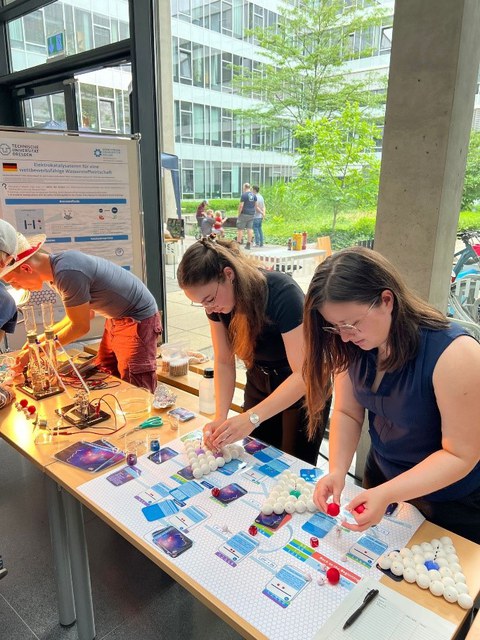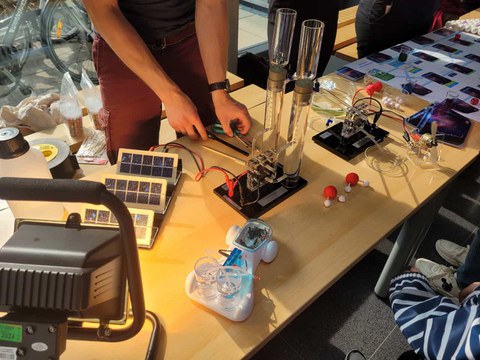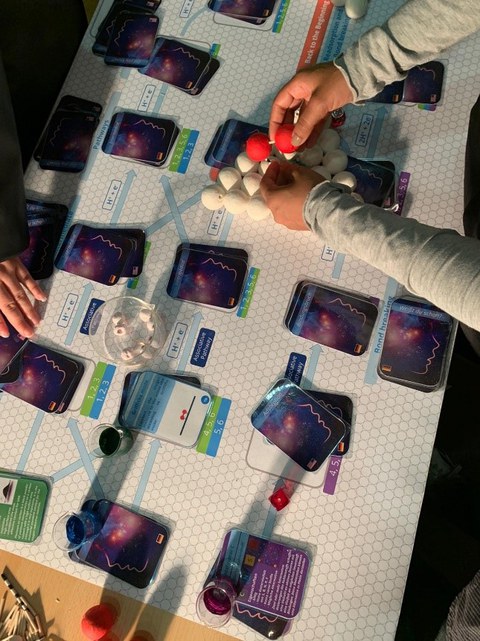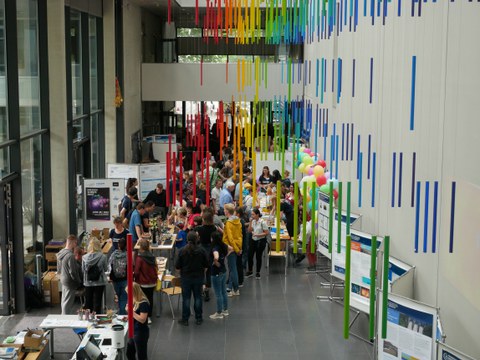Jul 07, 2023
20th Dresden Long Night of Sciences: Cluster G holds a booth about “Hydrogen - the future of our energy?”
The very last night of June was filled with science all around the city of Dresden. "Schlaugemacht bis Mitternacht" ("Clever until midnight") was the motto of the 20th Long Night of Sciences in Dresden.Research centers, universities, and science-related companies opened their doors to display their work to the general public.

Fig. 1: Final preparations - doctoral students Stefan Röher (left, project G2) and Lairana Lima Duarte (right, project G1) with student assistant Carmen Helbig (middle)
The Faculty of Chemistry and Food Chemistry of TU Dresden presented - like many others - captivating booths. These included ice cream made of liquid nitrogen, the possibility of making batteries from lemons, and also the booth of doctoral students from Cluster G (Electrocatalysts for a competitive hydrogen economy) on the topic of catalysis and hydrogen (see fig.1).
People of all ages came to see the miniature hydrogen plant (see fig. 2) consisting of the following components:
- A lamp that simulated sunlight.
- Solar panels producing renewable energy for the electrolyzer.
- An electrolyzer in which the separation of water into hydrogen (H2) and oxygen (O2) took place, which were temporarily stored in glass graduated cylinders.
- Measuring cylinders made of glass with stoppers, where the water level made it easy for the audience to see the change in volume when the gas was produced or used.
- Valves and glass tubes for gas distribution.
- A PEM fuel cell (Proton Exchange Membrane Fuel Cell PEMFC) in which the gases H2 and O2 were recombined to produce water, which was collected from a tube at the side of the cell. It also provided energy that was used to turn a small fan.

Fig. 2: Miniature hydrogen plant at the booth of Cluster G
Inside of the fuel cell, hydrogen is oxidized to H+ . In the process, electrons are released and energy is converted, while the oxygen is reduced at the cathode, closing the circuit. However, oxygen reduction is a much slower process than hydrogen oxidation, therefore, a catalyst is needed to speed up the reaction. The research work of Cluster G of the Boysen-TUD Research Training Group involves the development, understanding, and communication about electrocatalysts for the benefit of a competitive hydrogen economy. To complement the hydrogen plant, doctoral students Lairana Lima Duarte (sub-project G1), Stefan Röher (sub-project G2) and John Jursch (sub-project G3), together with student assistant Carmen Helbig, prepared an interactive game to illustrate the different ways of oxygen reduction to visitors.

Fig. 3: The game "The journey of an oxygen" was developed by Cluster G
The game "The journey of an oxygen" included catalyst cards with features about the industry benchmark (Platinum on activated carbon), nitrogen-doped carbons with metal centers like iron, and double-doped catalysts. Players first chose a color for the catalyst card that revealed which catalyst they were getting, and then rolled the dice to take the next step on the path to H2O or even H2O2 production. There was a risk of destroying their fuel cell. In addition, as the game progressed, players were asked to reproduce the card instructions on the molecular ball-and-stick model. Furthermore, the game included information cards that explained to the player some facts about each step, such as adsorption or bond breaking.
“Did you know? One gram of porous material can be as big as a World Cup football field!”
The booth also scored with a miniature car powered by a fuel cell, and a few controlled mini-explosions of hydrogen bubbles in soapy water.
To reach as many people as possible, posters were displayed in German and English presenting the production, use, and application of H2, the research interests of Cluster G, and the Research Training Group itself. The 20th Long Night of Sciences in Dresden was a complete success: from 5 p.m. to midnight, about 48,000 visitors attended the 1257 events organised by a total of 52 organisers!
More impressions of the event can be found at the following link:
https://www.wissenschaftsnacht-dresden.de/en/review

